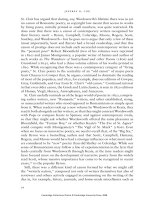The cambridge companion to british roman 38
Bạn đang xem bản rút gọn của tài liệu. Xem và tải ngay bản đầy đủ của tài liệu tại đây (38.64 KB, 1 trang )
j e f f r e y n . c ox
St. Clair has argued that during, say, Wordsworth’s lifetime there was as yet
no canon of Romantic poetry, as copyright law meant that access to works
by living poets, initially printed in small numbers, was quite restricted. He
does note that there was a canon of contemporary writers recognized for
their literary merit – Byron, Campbell, Coleridge, Moore, Rogers, Scott,
Southey, and Wordsworth – but he goes on to argue that only a few of these
(most importantly, Scott and Byron) had a broad readership, and that this
canon of prestige does not include such successful contemporary writers as
the “peasant poet” Robert Bloomfield (two of his volumes were reprinted
in 1820) and James Montgomery, a popular writer of hymns and author of
such works as The Wanderer of Switzerland and other Poems (1806) and
Greenland (1819), who had a three-volume edition of his works printed in
1820. While recognizing that there was a contemporary category of “living
poets,” St. Clair points to the centrality of an “old canon” of major poets
from Chaucer to Cowper that, he argues, continued to dominate the reading
of most of the populace; and 1820, for example, does see editions of Cowper,
Gray, Goldsmith, and Gay from St. Clair’s “old canon.” Continued interest
in that even older canon, the Greek and Latin classics, is seen in 1820 editions
of Homer, Virgil, Horace, Aristophanes, and Anacreon.
St. Clair usefully reminds us of the larger world of poetry in 1820, comprising earlier writers, new “Romantic” writers, and other established, rising,
or unsuccessful writers who stood opposed to Romanticism or simply apart
from it. When readers took up a new volume by Wordsworth or Keats, they
read it both alongside earlier writers, so that they might contrast Wordsworth
with Pope or compare Keats to Spenser, and against contemporary rivals,
so that they might ask whether Wordsworth offered the same pleasures as
Bloomfield, the “Farmer Boy,” or whether Keats’s “The Eve of St. Agnes”
could compete with Montgomery’s “The Vigil of St. Mark” (1806). Even
when we focus on innovative poetry, we need to recall that, of the “Big Six,”
only Byron was a bestselling author and that Scott, Campbell, Hemans,
Rogers, and Moore would have had a stronger influence on what most readers considered to be “new” poetry than did Shelley or Coleridge. While our
sense of Romanticism may follow a line of experimentation in the lyric that
leads centrally from Wordsworth through Keats, at the time readers might
have focused more on the development of narrative poetry from the widely
read Scott, whose massive importance has come to be recognized in recent
years,10 to the popular Byron.
Still, there was a different kind of canon formed by what we might call
the “writerly nation,” composed not only of writers themselves but also of
reviewers and others actively engaged in commenting on the writing of the
day in, for example, letters, journals, and home-made miscellanies such as
16
Cambridge Collections Online © Cambridge University Press, 2008









